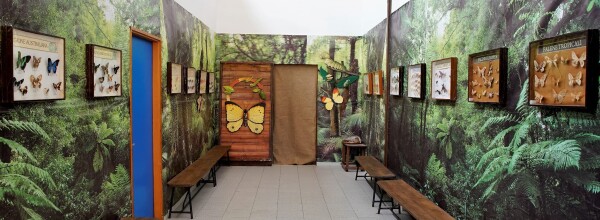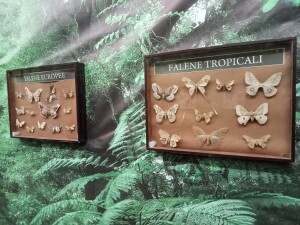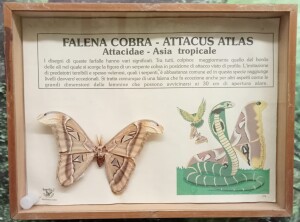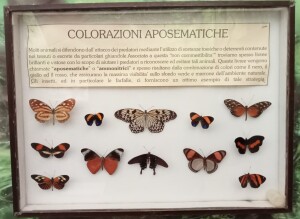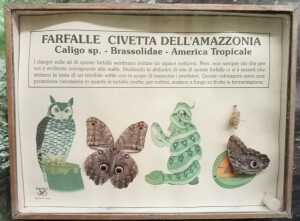Butterflies belong to the Lepidoptera order.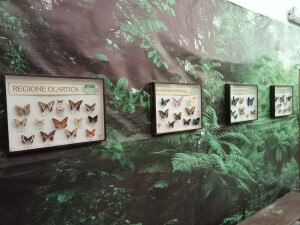
Lepidoptera are a large order of insects, second only to the beetles in the number of species described so far by entomologists. Fossils show that some butterfly species have been around for at least 50 million years. Lepidoptera inhabit all regions of the world, including the Arctic. Butterflies’ wingspans range from 1.6 centimeters for the blue pygmy butterfly (Brephidium exilis), found in the southern United States, to 30 centimeters for the Queen Alexandra butterflies (Ornithoptera alexandrae), which live in the rainforest of Papua. in New Guinea.
BUTTERFLY, HOW IS IT MADE?
 The Butterflies body is divided into three main parts: the head, the thorax and the abdomen. On the head we find the eyes, large, oval and compound, meaning they are made up of hundreds of individual photoreceptors. They are able to see in every direction at the same time and the spectrum of colors they can perceive goes far beyond the human one. Two antennas are positioned above the head, they are used for the sense of touch, but they also contain olfactory organs which aid in the search for food. Their mouth is between the eyes. The tongue, or proboscis, has the shape and function of a straw, which limits their diet to liquids only. When not in use it is kept coiled under the mouth and its length determines which flowers they feed on. Some moths do not have functioning mouthparts and do not eat at all once they are adults. In the thorax we always find six legs, attached at the bottom. In some families of butterflies the front pair of legs is not functional. All legs are jointed and have clawed feet, used for climbing. The feet contain touch sensors. The abdomen is long and contains the heart, digestive system, respiratory system, and sexual organs. Butterflies breathe by absorbing oxygen through openings located on the sides of the abdomen. The wings are very thin and delicate, yet are crisscrossed with a network of stiff veins that provide structural support. They can beat 8 to 12 times per second and some butterflies are capable of flying more than 900 km (about 560 miles) before stopping to rest. As for speed, the fastest specimen is able to fly at 60 km/h (about 37 miles for hour). Butterflies are able to fly to great altitudes, some can reach 3.000 meters (about 1.000 feet)!
The Butterflies body is divided into three main parts: the head, the thorax and the abdomen. On the head we find the eyes, large, oval and compound, meaning they are made up of hundreds of individual photoreceptors. They are able to see in every direction at the same time and the spectrum of colors they can perceive goes far beyond the human one. Two antennas are positioned above the head, they are used for the sense of touch, but they also contain olfactory organs which aid in the search for food. Their mouth is between the eyes. The tongue, or proboscis, has the shape and function of a straw, which limits their diet to liquids only. When not in use it is kept coiled under the mouth and its length determines which flowers they feed on. Some moths do not have functioning mouthparts and do not eat at all once they are adults. In the thorax we always find six legs, attached at the bottom. In some families of butterflies the front pair of legs is not functional. All legs are jointed and have clawed feet, used for climbing. The feet contain touch sensors. The abdomen is long and contains the heart, digestive system, respiratory system, and sexual organs. Butterflies breathe by absorbing oxygen through openings located on the sides of the abdomen. The wings are very thin and delicate, yet are crisscrossed with a network of stiff veins that provide structural support. They can beat 8 to 12 times per second and some butterflies are capable of flying more than 900 km (about 560 miles) before stopping to rest. As for speed, the fastest specimen is able to fly at 60 km/h (about 37 miles for hour). Butterflies are able to fly to great altitudes, some can reach 3.000 meters (about 1.000 feet)!
CYCLE OF LIFE
Butterflies undergo a complete metamorphosis: this means that each generation develops through four stages: egg, caterpillar , chrysalis and adult. The young hatch from an egg laid by the mother on the leaves of a host plant. How do they decide which plant is the right one? Through taste. If a female cannot find a host plant, she keeps the eggs until she does find one. Whichever plant is chosen as host will be one that the young will feed on, even the larvae will starve to death rather than eat from the wrong plant. As Caterpillar have an only purpose: to eat and gain body mass. They usually start by eating the shell of their eggs, after which they start eating the leaves and sometimes the flowers of the host plant. Many caterpillars don’t survive long enough to move on to the next stage of their life. Caterpillars are food for almost all carnivores, that means birds, mammals, spiders and beetles. Each of them eat caterpillars, they are a kind of hamburger in the world. Because their life is fraught with dangers, many species are equipped with defense mechanisms. Some have color patterns near the back that look like eyes, so they scare off predators. Others are colored to blend in with the host plant, or have prickly bristles or hairs that irritate anything that brushes against them. Other caterpillars give off an unpleasant smell, while others, however, such as the Monarch, are not touched because the plants they eat make them unpleasant to taste or even toxic. When a chemical matter called “juvenile hormone” reaches a certain level, the caterpillars undergo their final moult and eject all contents from their digestive tracts. At this point, they leave their host plant and look for a safe place to become chrysalises. The outer skin of the caterpillars hardens to form a chamber within which the transformation from caterpillar to adult butterfly takes place. The larva inside detaches from the walls and takes the name of pupa or chrysalis (the two words are synonymous). Some pupae of both butterflies and moths take a year to complete their life cycle, from egg to adult, but most complete the cycle in just 2-4 weeks. At the end of this cycle the casing of the chrysalis breaks, and a fully developed and sexually mature butterflies comes out.
On the right you can see the display cases of the Moths. What are the differences between butterflies and moths? To the untrained eye these two insects look very similar, but you can quickly learn the differences and, at a glance, lock for difference between a butterfly and a moth.
• Most butterflies are active during the day, while most moths are nocturnal;
• While resting, the butterfly holds its wings upright and together. Most moths hold their wings along their sides or folded together above their body;
• Almost all butterflies have brilliant colors. The moth is often, but not always, dull in color: brown, gray, black, or a combination of these. Its wings often have a very efficient camouflage pattern, making it almost invisible during the day;
• Butterflies’ antennae are shaped like a golf club: a shaft with a thicker ridge at the end. Those of moths, on the other hand, are similar to a comb, hairy or threadlike, but never club-shaped;
• The body of butterflies is generally smooth to the eye and slender, while that of a moth is plump and hairy.
EYES ON WINGS
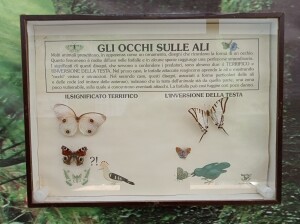 Many animals present, in appearance as an ornament, designs that remember the shape of an eye. This phenomenon is very common in butterflies and in some species reaches an extraordinary perfection. The meanings of these drawings, which confuse predators, are at least two: the “TERRIFIC” and the “REVERSE OF THE HEAD”. In the first one the attacked butterflies react by opening their wings and showing showy and threatening “eyes”. In the second one, these drawings, associated with particular shapes of wings and tails (to imitate the antennae), indicate that the animal’s head is on that side, a not vulnerable area, on which any attacks can be done. The butterfly can thus escape with a little damage.
Many animals present, in appearance as an ornament, designs that remember the shape of an eye. This phenomenon is very common in butterflies and in some species reaches an extraordinary perfection. The meanings of these drawings, which confuse predators, are at least two: the “TERRIFIC” and the “REVERSE OF THE HEAD”. In the first one the attacked butterflies react by opening their wings and showing showy and threatening “eyes”. In the second one, these drawings, associated with particular shapes of wings and tails (to imitate the antennae), indicate that the animal’s head is on that side, a not vulnerable area, on which any attacks can be done. The butterfly can thus escape with a little damage.
BATESIAN MIMICRY
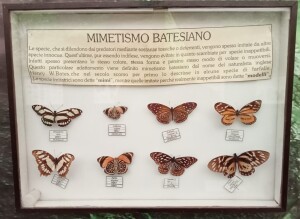 The species can defend themselves from predators by toxic or deterrent substances. Sometimes they are imitated by other harmless species.Tthe latter, despite being defenseless, are avoided as they are mistaken for unappetizing species. in fact they often have the same color, the same shape and even the same way of flying or moving. this particular adaptation is called “Batesian Mimicry” from the name of the English naturalist Henry W. Bates, who in the last century was the first to describe it in some species of butterflies. the imitating species are called “mimes”, while those imitated because they are really unappetizing, are called “models”.
The species can defend themselves from predators by toxic or deterrent substances. Sometimes they are imitated by other harmless species.Tthe latter, despite being defenseless, are avoided as they are mistaken for unappetizing species. in fact they often have the same color, the same shape and even the same way of flying or moving. this particular adaptation is called “Batesian Mimicry” from the name of the English naturalist Henry W. Bates, who in the last century was the first to describe it in some species of butterflies. the imitating species are called “mimes”, while those imitated because they are really unappetizing, are called “models”.
COBRA MOTH – ATTACUS ATLAS
The drawings of these butterflies have various meanings. Among all, the most interesting is related to the edge of the wings. On them you can see the profile of a Cobra snake in an attack position. To copy fearsome and poisonous predators such as snakes is quite common and in this species it reaches truly exceptional levels. However, it is a Moth very interesting for other aspects such as the large size of the females that can approach 30 cm of wingspan (about a feet).
CRITICAL MIMICRY
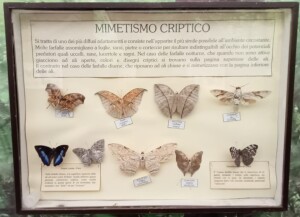 It is one of the most widespread adaptations and consists in appearing as similar as possible to the surrounding environment. Many butterflies have a look quite similar at leaves, branches, stones or barks to be indistinguishable to the eye of potential predators such as birds, frogs, lizards and spiders. In case of moths, which when they are not active lie with open wings, cryptic colors and designs are on the upper part of the wings, on the contrary for daytime butterflies, which rest with closed wings, their camouflage is on the external part of the wings.
It is one of the most widespread adaptations and consists in appearing as similar as possible to the surrounding environment. Many butterflies have a look quite similar at leaves, branches, stones or barks to be indistinguishable to the eye of potential predators such as birds, frogs, lizards and spiders. In case of moths, which when they are not active lie with open wings, cryptic colors and designs are on the upper part of the wings, on the contrary for daytime butterflies, which rest with closed wings, their camouflage is on the external part of the wings.
APOSEMATIC COLORS
Many animals defend themselves from attack by predators using toxic substances or deterrents contained in the tissues or secreted by particular glands. Associated with this “inedibility” we often find bright and showy liveries with the aim of helping predators to recognize and avoid these animals. Those liveries are called “Aposematics” or “Announcers” and often result from the combination of colors such as black, yellow and red, which ensure maximum visibility against the green or brown background of the natural environment. Insects, and especially butterflies, provide us with an excellent example of this strategy.
The designs on the wings of these butterflies seem to imitate a nocturnal bird of prey. These colors are a necessary protection as the owl butterflies stop for a long time on fruit in fermentation to feed. As far as is known, these physical characteristics serve as an effective method to go unnoticed by predators, or even to scare them. They seem bigger and more dangerous than they really are. However, butterflies preferentially fly at dusk when few predatory birds are around. The Latin name may perhaps refer to their active periods; caligo means “darkness”.

